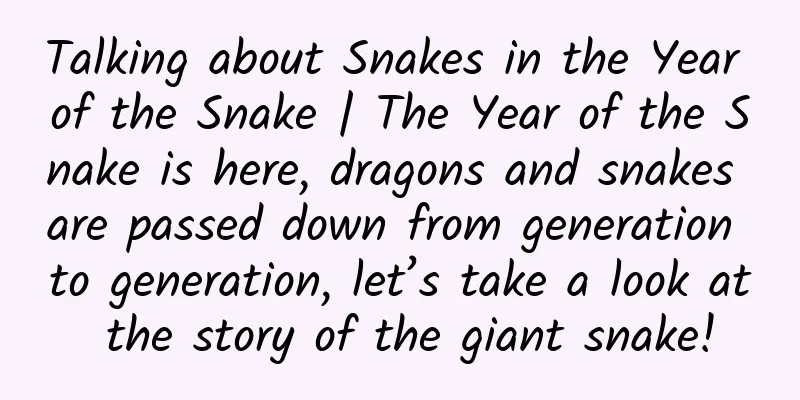Talking about Snakes in the Year of the Snake | The Year of the Snake is here, dragons and snakes are passed down from generation to generation, let’s take a look at the story of the giant snake!

|
Warning: This article contains multiple photos of snakes Bidding farewell to the Year of the Dragon, the Year of the Snake is here. We often call snakes little dragons, and snakes happen to be one of the reference prototypes of dragons. Scholar Wen Yiduo believes that the dragon totem was created based on the snake and combined with the characteristics of other animals. Even on some dragon artifacts, you can still see the obvious characteristics of snakes. So, are there any giant snakes in the world that can grow to be as big as dragons? Yes, there are, but the specific sizes and the ages of these snakes vary. As we bid farewell to the old and usher in the new, let's talk about this. Note: There are different opinions about the prototype of the dragon, such as crocodile, thunder and lightning, rainbow, etc. From dinosaurs to the Ice Age: Giant snakes of antiquity - Megalospermidae Last year, in the Year of the Dragon, a giant snake was discovered . It is the Indian king snake ( Vasuki indicus ), which can be up to 11-15 meters long and comes from South Asia. It is also called the Indian Vasuki snake. Its name is inseparable from Indian mythology. It once roamed in the water and marshes of South Asia more than 40 million years ago. Reconstruction of the Indian King Cobra, source: Nature website The fossil skeleton of the Indian king snake was discovered by the academic community at the beginning of this century, but no one paid attention to its fossils at first and regarded them as crocodiles. However, the description of bone morphology confirmed their identity as giant snakes. These giant snakes weighing up to one ton would prey on catfish and crocodiles in the water as their food. Indian King Snake Fossil The Indian king snake comes from a long-extinct group of snakes, the Madtsoiidae. Madtsoiidae were active on Earth as early as the Late Cretaceous during the dinosaur era. The ancient rift-mouthed snake ( Sanajeh ) even attacked small dinosaurs in their nests. The cow valley snake ( Madtsoia ) on the island of Madagascar was the largest snake in the dinosaur era, with a body length of 5-8 meters, which is also one of the longest among today's snakes. Reconstruction of the ancient rift-mouthed snake, source: dinopedia.wikia.com Cow Valley snake skeleton, source: fossil.wikia.com Afterwards, the giant snake family escaped the mass extinction that killed the non-avian dinosaurs and "branched out" in the Cenozoic Era, evolving into many members and leaving fossils in Europe, Africa and Asia. At the end of the Ice Age more than 10,000 years ago, they faced extinction. The last member of the Megalosaurus family was the Australian rainbow snake (Wonambi), which can reach 5-6 meters in length. The giant python of the past water villages At the end of the dinosaur era, while the giant snakes were dominating the world, there was also an extremely large snake that settled in the forest wetlands of South America - this was the Titanoboa , which belonged to the superfamily Booidea in the snake family. The length of Titanoboa is very close to that of the Indian King Snake mentioned above, which is also more than ten meters long and weighs one ton. Their fossils were found in the Cerrejón coal mine in South America 60-58 million years ago. The environment they lived in was also a water town with an average annual temperature of hot summer and rivers and lakes everywhere. The water environment can support their bodies to swim faster. Titan Anaconda restoration image, source: thereptilegoth.com The picture shows the Titanoboa's current relative, the red-tailed anaconda of the superfamily Anaconda, taken at Tianjin Zoo Note: If the scientific name of the Titanoboa is added with the specific epithet "cerrejonensis", it should be called Titanoboa cerrejonensis . This specific epithet is to commemorate the place where their names come from. There is also the Southwestern Cobra ( Naja fuxi ) in China. The specific epithet "fuxi" of this snake comes from Fuxi, who has a human head and a snake body. In the snake family, the Anaconda superfamily and the Pythonidae are always collectively referred to as "pythons" by us, but in fact, in terms of classification, they are somewhat distantly related, and it is more appropriate to call the former anacondas and the latter pythons. Not all pythons are four or five meters long. There are also many " little cuties ", such as the ball pythons kept as pets in some countries, which are only over one meter long. China's red sand boa ( Eryx miliaris ) is distributed in Xinjiang and other places. It is a key protected animal and a small guy that is only half a meter to one meter long. Ball python, photographed at Tianjin Zoo The red sand anaconda is a key protected animal in China and is also the prototype of the legendary Mongolian worm monster. Image source: Wikipedia So, how big are today's large pythons? This brings us to the reticulated python ( Malayopython reticulatus ) in Malaysia, the Philippines and Indonesia, as well as the northern green anaconda ( Eunectes akayima ) and southern green anaconda ( Eunectes murinus ) sisters in tropical South America. These three types of snakes are about 5-7 meters long and weigh 50-120 kilograms. A large green anaconda. Image source: reptilefact official website The green anaconda has gained weight. Image source: mutually.com Regarding the length of the reticulated python and the two green anacondas, the academic community believes that there are likely to be snakes longer than the current records. After all, the two green anacondas measured today are mainly found in warm grasslands that are easy for humans to reach and have more small prey, which cannot support snakes that are too large. In rainforest areas that are rarely visited by humans and have more large prey, there may be unknown giant snakes lurking. As snakes Their body length grows throughout their life The older the snake is, The longer the body length Reticulated python in Beijing Zoo, photographed by the author The Burmese pythons ( Python bivittatus , their official Chinese name is just "python") of South China and Yunnan Province are also big snakes, with a body length of 3-5 meters and a weight of 30-70 kilograms, which is close to that of leopards and gray wolves . Some even weigh more than reticulated pythons - the Burmese python that created this record is named "Baby", and this big baby weighs more than 182 kilograms. Burmese python, photographed at Tianjin Zoo Note: Related research last year believed that the northern green anaconda and the southern green anaconda are two different species, and the two parted ways about 10 million years ago, and their distribution areas are also different. Of course, there are also objections in the academic community. King of Vipers There are non-venomous snakes that are very large, but what about venomous snakes? Actually, there are also large ones, but they are not particularly large. The northern king cobra ( Ophiophagus hannah ), which is now entrenched in Guangdong, Guangxi, Yunnan, Fujian, Hainan Island, India, Thailand and other places abroad, is a typical example. It is also called the mountain king cobra. In the warm forests of southern China, it can be said to be a big overlord and a national second-class protected animal. They love to eat other snakes. Image source: le-sanctuaire-de-kennel.fr A northern king cobra fed with mice. Image source: zoochat.com Wait a moment, Why is it called "Northern King Cobra"? This is because it has close relatives such as the Luzon king cobra ( Ophiophagus salvatana ), the Sunda king cobra ( Ophiophagus bungarus ), and the Western Ghats king cobra ( Ophiophagus kaalinga ) as its brothers and sisters. Previously, the academic community thought that all four of them were the same species of king cobra, but in the fall of 2024, based on research on tooth morphology, body color, molecular biology, etc., the academic community discovered that the original king cobra should be divided into four different king cobras, and the distribution and appearance of these four king cobras are also different. Sunda King Cobra Among them, the northern king cobra is the king cobra that can be seen in China. They have obvious yellow stripes on their bodies and relatively more teeth in their mouths. The Luzon king cobra is gray-brown and has a relatively long tail. The Sunda king cobra has relatively fewer teeth, and the Western Ghats king cobra is smaller. King Cobra Grey King Cobra The total length of the four of them is roughly two to four meters, and there are records of very large individuals that are over five meters long. There was once a record that a northern king cobra in Southeast Asia was 5.5 meters long. Among the four "kings" of king cobras, the northern king cobra can be said to be the "eldest son" of the four king cobras because of its wide distribution and large size. However, the family members have some commonalities. As the king of snakes, it is common for them to eat other snakes. Among these three types of giant snakes that have evolved from ancient times to the present, which one do you think is the most domineering? I hope that in the new year, all the audience can live like them and create new heights in their own fields! END References Wilson, JA; Mohabey, DM; Peters, SE; Head, JJ (2010). Benton, Michael J., ed. "Predation upon Hatchling Dinosaurs by a New Snake from the Late Cretaceous of India". PLoS Biology. 8 (3): e1000322. doi:10.1371/journal.pbio.1000322. PMC 2830453. PMID 20209142. Debajit Datta, and Sunil Bajpai, Largest known madtsoiid snake from warm Eocene period of India suggests intercontinental Gondwana dispersal, 18 April 2024, Scientific Reports.DOI: 10.1038/s41598-024-58377-0 Scanlon, JD (2006). "Skull of the large non-macrostomatan snake Yurlunggur from the Australian Oligo-Miocene". Nature. 439 (7078): 839–842. doi:10.1038/nature04137.PMID 16482156 Disentangling the Anacondas: Revealing a New Green Species and Rethinking Yellows † Diversity 2024, 16(2), 127; https://doi.org/10.3390/d16020127Species Profile - Burmese Python (Python molurus bivittatus). National Invasive Species Information Center, United States National Agricultural Library. Tuniyev, B.; Ananjeva, NB; Aghasyan, A.; Orlov, NL; 2021: e.T157269A746649. Retrieved 8 March 2022. The Reptile Database.www.reptile-database.org Barker, DG; Barten, SL; Ehrsam, JP & Daddono, L. (2012). "The corrected lengths of two well-known giant pythons and the establishment of a new maximum length record for Burmese Pythons, Python bivittatus" (PDF). Bulletin of the Chicago Herpetological Society. 47 (1): 1–6. Retrieved 2020-03-02. Article Taxonomic revision of the king cobra Ophiophagus hannah (Cantor, 1836) species complex (Reptilia: Serpentes: Elapidae), with the description of two new species ArticleBiogeographic Inferences on the Evolutionary History of the King Cobra (Ophiophagus hannah, Cantor 1836) Species Complex Aglionby, John (2004-01-05) "Stay still, will you?". Guardian. Retrieved on 2012-08-21. Pizzatto, Lígia; Marques, Otavio; Facure, Kátia (2009). "Food habits of Brazilian boid snakes: overview and new data, with special reference to Corallus hortulanus". Amphibia-Reptilia. 30 (4). Brill Publishers: 533–544. doi:10.1163/156853809789647121. ISSN 0173-5373. Reproductive Biology and Phylogeny of Snakes. CRC Press. 2016. pp. 573–586. ISBN 978-1-4398-5833-2. Rivas, Jesús. "Predatory attacks of green anacondas (Eunectes murinus) on adult human beings". Archived from the original on 11 April 2019. Wood, Gerald L. (1982). The Guinness Book of Animal Facts and Feats (3 ed.). London: Guinness Superlatives. ISBN 0-85112-235-3. The Guinness book of animal facts and feats at the Internet Archive. Head, JJ; Bloch, JI; Hastings, AK; Bourque, JR; Cadena, EA; Herrera, FA; Polly, PD; Jaramillo, CA (2009). "Giant boid snake from the paleocene neotropics reveals hotterpast equatorial temperatures". Nature 457 (7230): 715–718.doi:10.1038/nature07671. PMID 19194448. https://animalia.bio official website National Wildlife Protection List Related content on Wikipedia EOL official website related content Author: Great Qing Dragon Editor: Dong Xiaoxian Reviewer: Zhang Chao, Li Peiyuan |
Recommend
APP promotion: the latest advertising price list of the top ten domestic app stores in 2015
Note: The top ten domestic Android stores are lis...
Tesla braked for no reason and then accelerated automatically. The owner called customer service and the driving record was remotely deleted
Recently, there have been frequent news reports a...
5 tips to improve APP retention rate
Attracting users to download is the first priorit...
Ground-based economy: the most traditional mode of operation and the most economical mode of attracting new customers
1. Team Building In terms of team building, the c...
Hunan Satellite TV takes back the video broadcasting rights: digging a hole for itself?
On May 8, Hunan TV announced that it would no lon...
In-depth understanding of Android Studio Sync process
1. Getting to know Sync We generally understand S...
Many people make mistakes when uninstalling mobile phone software. Only by doing this can the software be deleted cleanly.
Everyone will increase the space and memory of th...
Why are there only salted duck eggs but no salted chicken eggs?
Author: Gongzi Xin When you have breakfast or por...
Tik Tok promotion strategy, how to come up with a Tik Tok title?
Tik Tok is a popular product. Many individuals, t...
The "little apple" from 400 million years ago was fixed to the seabed like an anchor!
From the middle Ordovician to the late Devonian, ...
It is a low probability event for a small enterprise to become a large enterprise
People usually believe that it is difficult to ru...
Orange high temperature warning! The highest temperature in many places can reach above 37℃. How to deal with the "burning" test?
The Central Meteorological Observatory continued ...
"I have breast cancer? But I'm a man!"
Expert in this article: Shi Libin, Director of th...
WP8.1 preview version upgrade
Microsoft has officially started pushing WP8.1 upd...
In the wearable era, make your own cool smartwatch
Editor's Note: This project is called RetroWa...



![[Epidemic Prevention Science Popularization] As spring comes and flowers bloom, how can patients with allergic rhinitis protect themselves?](/upload/images/67f2a76f9645e.webp)





